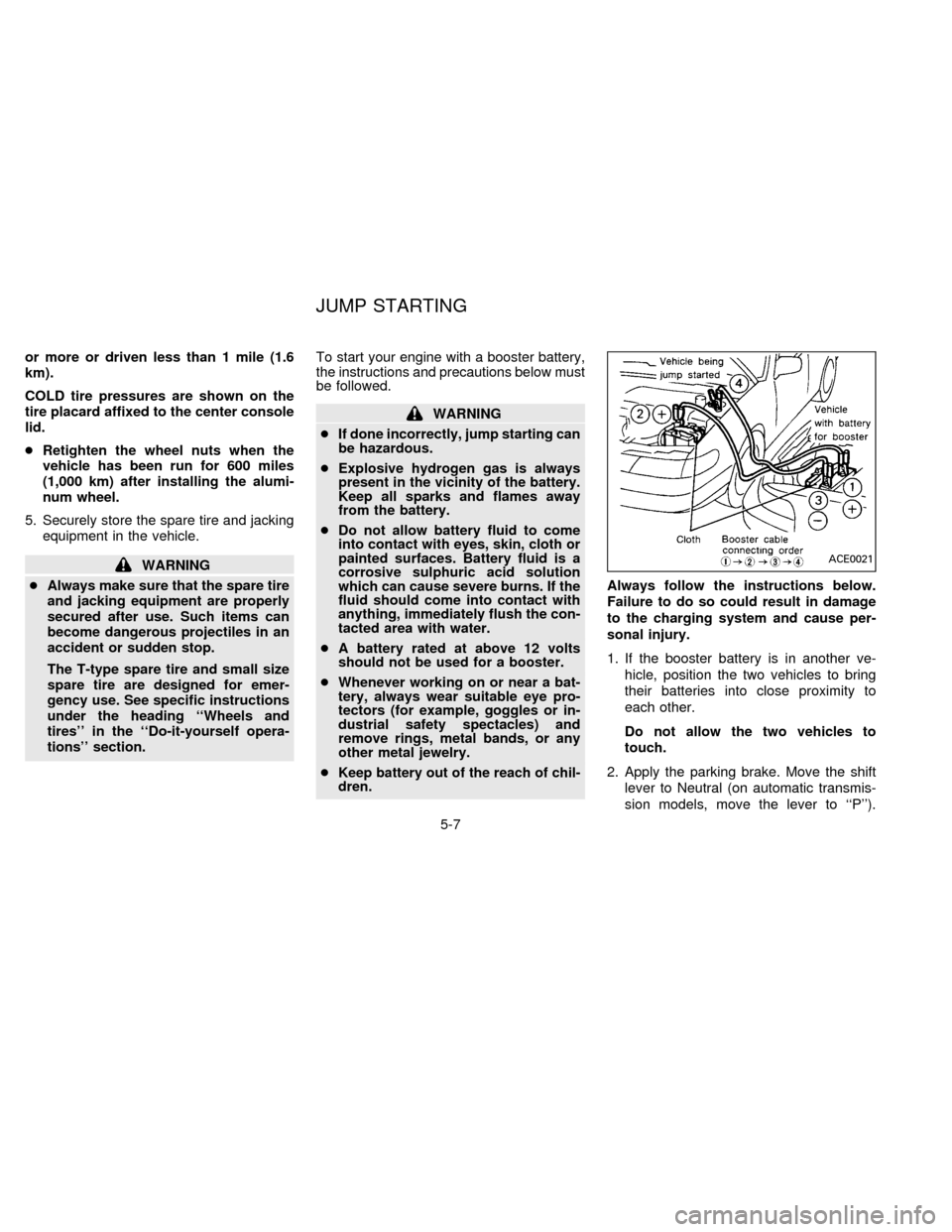1996 NISSAN ALTIMA battery
[x] Cancel search: batteryPage 24 of 183

NOTE: Leaving the interior light switch in
the ªONº position for extended periods of
time will result in a discharged battery.The light illuminates when the trunk lid is
opened. When the trunk lid is closed, the
light will go off.
IC1019
IC1278
SPOTLIGHT (If so equipped) TRUNK LIGHT
1-19
ZX
Page 70 of 183

than 2 seconds. For example, in the
diagram ch2 is to be memorized. The
radio mutes when the select button is
pushed.
3. The indicator ``ch2'' will then come on
and the sound will resume. Memorizing is
now complete.
4. Other select buttons can be set in the
same manner.
If the battery cable is disconnected, or if the
fuse blows, the radio memory will be can-
celled. In that case, reset the desired sta-
tions.
Adjusting tone quality and speaker
balance
To adjust BASS, TREB (treble), FADER,
and BAL (balance) the control knobs must
be released from their stowed positions.
Pushing the knobs once moves them to the
released position.
In the released position, the knobs control
tone quality. Turn the control knobs to adjust
BASS and TREB to the most pleasing level.
From the released position, the knobs must
be pulled out in order to control FADER and
BAL. FADER adjusts the sound level be-tween the front and rear speakers, and BAL
adjusts the sound level between the right
and left speakers.
Once sound quality is set to the desired
levels, return the control knobs to the
stowed position by pushing them in com-
pletely and releasing.
Cassette tape operation
Turn the ignition key to ``ACC'' or ``ON'', then
carefully insert the cassette tape into the
tape door.
The cassette tape will automatically pull into
the player. The word ªTAPEº and an arrow
AHA0522
3-13
ZX
Page 75 of 183

next broadcasting station. Once the highest
broadcasting station is reached, the radio
will continue in the ªSEEKº mode at the
lowest broadcasting station. If using the
``
'' button, once the lowest broadcast-
ing station is reached, the radio will continue
in the ``SEEK'' mode at the highest broad-
casting station. Pushing the button again
will continue the ªSEEKº function.
SCAN tuning
Push the SEEK/SCAN tuning button ``
''
or ``'' for more than 1.5 seconds. SCAN
tuning begins from low to high frequencies
or high to low frequencies, depending on
which button is pressed. SCAN tuning stops
at each broadcasting station for five sec-
onds. Pushing the button again during this
five second period will stop SCAN tuning
and the radio will remain tuned to that
station.
Station memory operations
Six stations can be set for each band.
1. Tune to the desired station.
2. Push the desired select button for morethan 3 seconds. (For example, in the
diagram ch2 is to be memorized. The
radio stops playing momentarily when
the select button is pushed.)
3. The indicator ``ch2'' will then illuminate in
the display and the sound will resume.
Memorizing is now complete.
4. Other buttons can be set in the same
manner.
If the battery cable is disconnected, or if the
radio fuse blows, the radio memory will be
cancelled. In that case, reset the desired
stations.
Cassette tape operation
Turn the ignition key to ``ACC'' or ``ON'', and
then lightly insert the cassette tape into the
tape door. The cassette tape will be auto-
matically pulled into the player.
The radio or CD will turn off (if it is on) and
the cassette tape will begin to play.
Do not force the cassette tape into the
tape door.
Pressing strongly could cause player
damage.
If the system is turned off by pushing the
AHA0503
3-18
ZX
Page 85 of 183

The automatic transmission in your vehicle
(if so equipped) is electronically controlled
by the A/T control unit to produce maximum
power and smooth operation.
Shown on the following pages are the rec-
ommended operating procedures for this
transmission. Follow these procedures for
maximum vehicle performance and driving
enjoyment.
Starting the vehicle
cAfter starting the engine, fully depress the
foot brake pedal before shifting the selector
lever to the ``D'', ``R'', ``2'' or ``1'' position.
Be sure the vehicle is fully stopped before
attempting to shift the selector lever.
This automatic transmission is designed
so that the foot brake pedal MUST be
depressed before shifting from ``P'' to
any drive position while the ignition
switch is ``ON''.
The shift lever cannot be moved out of
``P'' and into any of the other gear posi-
tions if the ignition key is turned to
``OFF'' or if the key is removed.
When the battery charge is low, the shift
lever can be moved if the ignition switch
is in the ``ACC'' position.1. Keep the foot brake pedal depressed and
shift into a driving gear.
2.Release the parking brake and foot brake,
then gradually start the vehicle in motion.
CAUTION
cCold engine idle speed is high, so
use caution when shifting into a for-
ward or reverse gear before the en-
gine has warmed up.
c
Avoid revving up the engine while the
vehicle is stopped. This could cause
unexpected vehicle movement.
Driving precautions
To help prevent transmission damage:
c
Do not depress the accelerator pedal
while shifting from ``P'' or ``N'' to ``R'',
``D'', ``2'' or ``1''. Always depress the
brake pedal until shifting is completed.
cNever shift to ``P'' or ``R'' while the
vehicle is moving.
cWhen stopping the vehicle on an up-
hill grade, do not hold the vehicle by
depressing the accelerator pedal. The
foot brakes should be used for this
purpose.
ASD0510
DRIVING WITH AUTOMATIC
TRANSMISSION
4-6
ZX
Page 96 of 183

Freeing a frozen door lock
To prevent a door lock from freezing, apply
de-icer or glycerin to it through the key hole.
If the lock becomes frozen, heat the key
before inserting it into the key hole.
Anti-freeze
In the winter when it is anticipated that the
temperature will drop below 32ÉF (0ÉC),
check anti-freeze (ethylene glycol base) to
assure proper winter protection. For details,
see ``Engine Cooling System'' in the ``Do-it-
yourself operations'' section.
Battery
If the battery is not fully charged during
extremely cold weather conditions, the bat-
tery fluid may freeze and damage the bat-
tery. To maintain maximum efficiency, the
battery should be checked regularly. For
details, see ``Battery'' in the ``Do-it-yourself
operations'' section.
Draining of coolant water
If the vehicle is to be left outside without
anti-freeze, drain the cooling system by
opening the drain valves located under the
radiator and on the engine block. Refillbefore operating the vehicle. See ``Chang-
ing Engine Coolant'' in the ``Do-it-yourself
operations'' section.
Tire equipment
1. The SUMMER tires are of a tread design
to provide superior performance on dry
pavement. However, the performance of
these tires will be substantially reduced
in snowy and icy conditions. If you oper-
ate your vehicle on snowy or icy roads,
NISSAN recommends the use of MUD &
SNOW or ALL SEASON tires on all four
wheels. Please consult your NISSAN
dealer for the tire type, size, speed rating
and availability information.
2. For additional traction on icy roads, stud-
ded tires may be used. However, some
provinces and states prohibit their use.
Check local, state and provincial laws
before installing studded tires.
Skid and traction capabilities of studded
snow tires, on wet or dry surfaces, may
be poorer than that of non-studded snow
tires.3. Snow chains may be used if desired.
Make sure they are of proper size for the
tires on your vehicle and are installed
according to the chain manufacturer's
suggestions.
Use of tire chains may be prohibited accord-
ing to location. Check the local laws before
installing tire chains. When installing tire
chains, make sure they are of proper size
for the tires on your vehicle and are installed
according to the chain manufacturer's sug-
gestions.Use only SAE Class ``S'' chains.
Other types may damage your vehicle. Use
chain tensioners when recommended by
the tire chain manufacturer to ensure a tight
fit. Loose end links of the tire chain must be
secured or removed to prevent the possibil-
ity of whipping action damage to the fenders
or underbody. If possible, avoid fully loading
your vehicle when using tire chains. In ad-
dition, drive at a reduced speed. Otherwise,
your vehicle may be damaged and/or ve-
hicle handling and performance may be
adversely affected.
Never install tire chains on T-type and small
size spare tires. Do not use the chains on
dry roads.
COLD WEATHER DRIVING
CAUTIONS
4-17
ZX
Page 104 of 183

or more or driven less than 1 mile (1.6
km).
COLD tire pressures are shown on the
tire placard affixed to the center console
lid.
cRetighten the wheel nuts when the
vehicle has been run for 600 miles
(1,000 km) after installing the alumi-
num wheel.
5. Securely store the spare tire and jacking
equipment in the vehicle.
WARNING
cAlways make sure that the spare tire
and jacking equipment are properly
secured after use. Such items can
become dangerous projectiles in an
accident or sudden stop.
The T-type spare tire and small size
spare tire are designed for emer-
gency use. See specific instructions
under the heading ``Wheels and
tires'' in the ``Do-it-yourself opera-
tions'' section.To start your engine with a booster battery,
the instructions and precautions below must
be followed.
WARNING
cIf done incorrectly, jump starting can
be hazardous.
cExplosive hydrogen gas is always
present in the vicinity of the battery.
Keep all sparks and flames away
from the battery.
cDo not allow battery fluid to come
into contact with eyes, skin, cloth or
painted surfaces. Battery fluid is a
corrosive sulphuric acid solution
which can cause severe burns. If the
fluid should come into contact with
anything, immediately flush the con-
tacted area with water.
cA battery rated at above 12 volts
should not be used for a booster.
cWhenever working on or near a bat-
tery, always wear suitable eye pro-
tectors (for example, goggles or in-
dustrial safety spectacles) and
remove rings, metal bands, or any
other metal jewelry.
c
Keep battery out of the reach of chil-
dren.
Always follow the instructions below.
Failure to do so could result in damage
to the charging system and cause per-
sonal injury.
1. If the booster battery is in another ve-
hicle, position the two vehicles to bring
their batteries into close proximity to
each other.
Do not allow the two vehicles to
touch.
2. Apply the parking brake. Move the shift
lever to Neutral (on automatic transmis-
sion models, move the lever to ``P'').
ACE0021
JUMP STARTING
5-7
ZX
Page 105 of 183

Switch off all unnecessary electrical
systems (lights, heater, air conditioning,
etc.).
3. Remove vent caps on the battery (if so
equipped). Cover the battery with an old
cloth to reduce explosion hazard.
4. Connect jumper cables in the sequence
as illustrated.
CAUTION
cAlways connect positive (+) to posi-
tive (+) and negative (þ) to body
ground (for example, strut mounting
bolt, etc. Ð not to the battery).
cMake sure that cables do not touch
moving parts in the engine compart-
ment and that clamps do not contact
any other metal.
5. Start the engine of the booster vehicle
and let it run for a few minutes.
6. Keep the engine speed of the booster
vehicle at about 2,000 rpm, and start
your engine in the normal manner.
CAUTION
Do not keep starter motor engaged for
more than 10 seconds. If the engine
does not start right away, turn the key
off and wait 3 to 4 seconds before
trying again.
7. After starting your engine, carefully dis-
connect the negative cable and then the
positive cable.
8. Replace the vent caps (if so equipped).
Be sure to dispose of the cloth used to
cover the vent holes as it may be con-
taminated with corrosive acid.CAUTION
cAutomatic transmission models can-
not be push started. This may cause
transmission damage.
cThree way catalyst equipped models
should not be started by pushing
since the three way catalyst may be
damaged.
cNever try to start the vehicle by tow-
ing it; when the engine starts, the
forward surge could cause the ve-
hicle to collide with the tow vehicle.
PUSH STARTING
5-8
ZX
Page 116 of 183

7 Do-it-yourself operations
Maintenance precautions ..................................... 7-2
Engine compartment check locations ................. 7-3
Engine cooling system ......................................... 7-4
Engine oil.............................................................. 7-7
Automatic transmission fluid (ATF) ...................... 7-9
Power steering fluid............................................ 7-11
Brake and clutch fluid......................................... 7-11
Window washer fluid .......................................... 7-12
Battery ................................................................ 7-13
Drive belts .......................................................... 7-14
Spark plug replacement ..................................... 7-14Air cleaner housing filter .................................... 7-15
Wiper blades ...................................................... 7-16
Parking brake check........................................... 7-17
Brake pedal ........................................................ 7-18
Brake booster ..................................................... 7-19
Clutch pedal ....................................................... 7-19
Fuses .................................................................. 7-19
Fusible links........................................................ 7-21
Light bulbs .......................................................... 7-21
Wheels and tires ................................................ 7-28
ZX